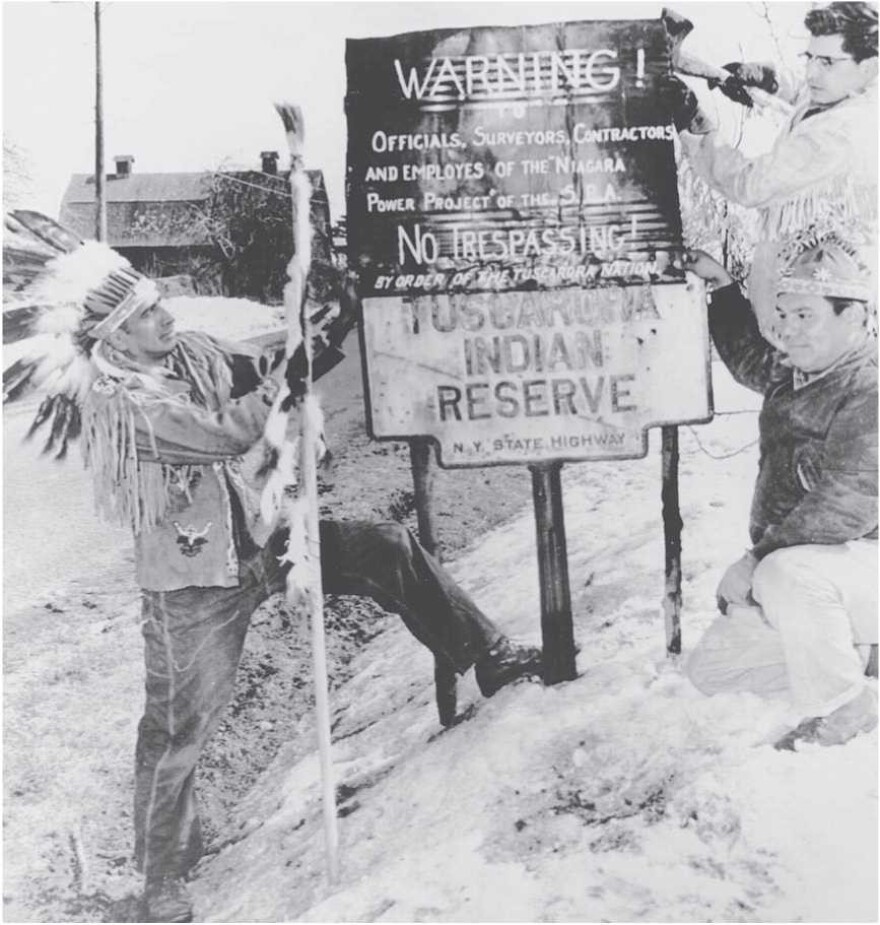It was nothing less than the forced displacement of almost 700 people, and more than 50 years later the memory of it still haunts those families and their descendants.
Since 1794 members of the Seneca Nation had lived on the Allegany Reservation and the adjacent Cornplanter Tract, lands covering some 30,000 verdant acres in southwestern New York and northwestern Pennsylvania. The U.S .government pledged the land to the Senecas via the Treaty of Canandaigua, signed by 59 sachems and war chiefs and by the official agents of President George Washington — and affirmed by Washington himself.
“Now,” read the treaty, which officially recognized the land rights of the Haudenosaunee Confederacy, “the United States acknowledge all the land within the aforementioned boundaries, to be the property of the Seneka nation; and the United States will never claim the same, nor disturb the Seneka nation, nor any of the Six Nations, or of their Indian friends residing thereon.”
But a century and a half later, the U.S. government did indeed disturb the people residing thereon. The Army Corps of Engineers decided to build a flood-control and hydroelectric dam across the Allegheny River — one that would inundate one-third of the Senecas’ reservation. The government took control of the land via eminent domain. The construction of the Kinzua Dam had begun.

The Senecas protested. Led by their president, George Heron, they proposed an alternative site for the dam that would not flood ancestral lands; took the government to court; and lobbied Congress and President Dwight D. Eisenhower, then his successor, John F. Kennedy. But the Army Corps rejected the alternative plan. The courts ruled in favor of the government, and the Supreme Court declined to hear the Senecas’ appeal. Finally, President Kennedy refused to stop the project.
“I have now had an opportunity to review the subject and have concluded that it is not possible to halt the construction of Kinzua Dam currently under way,” JFK wrote to the Seneca Nation in an August 1961 letter. “I hope you will convey to the members of the Seneca Nation the desire of the Federal Government to assist them in every proper way to make the adjustment as fair and orderly as possible. I pledge you our cooperation.”
By 1965 the Senecas, their homes in Coldspring, Quaker Bridge, Shongo, Onoville, Red House, Cornplanter, SunFish, Bay State, Old Town and Bone Run bulldozed or burned, were removed to new villages on the New York side of the reservation. Cemeteries and religious sites were flooded and covered over by the reservoir — Lake Perfidy, the Senecas mordantly called it.
So blatant was the injustice of the Kinzua Dam that even white Americans, traditionally unmoved by Native American grievances, took notice. The former First Lady Eleanor Roosevelt called it “a shameful thing.” The New York Times theater critic Brooks Atkinson wrote, “the consistent harassment of the Seneca Nation constitutes an intolerable stain on the honor of the United States.” And Johnny Cash recorded an album about the injustices done to Indigenous people, “Bitter Tears,” that included a song about the Kinzua Dam called “As Long as the Grass Shall Grow.”

The Senecas were uprooted from their lands, but they never forgot. Every September they gather for the Remember the Removal Walk, a solemn procession from Red House Bridge to Steamburg Barricade. Local news media commemorate the removal with eloquent articles and TV reports, as do the national media. Moving radio and https://vimeo.com/230629755">film documentaries tell the painful story of what happened at the Kinzua Dam.
But the most moving words come from the displaced residents themselves, people like Rebecca Bowen, who as a little girl was displaced along with her family. In 2011, Bowen testified before the Federal Energy Regulatory Commission.
“Like an occupation force, an army of construction companies invaded our homeland,” she told the commissioners.
“Our lives were changed forever. The waters that generate the power flow over our old homesteads where the longhouse once stood, the foundations of our churches, our school, our old ballfields, even the graves of Senecas. …”
Cast (in order of appearance):
President George Washington: Richard Lambert
Rebecca Bowen: Rebecca Bowen
Narrator: Susan Banks
Sound recording: Micheal Peters
Sound editing: Micheal Peters
Produced by the Niagara Frontier Heritage Project
Written by Jeff Z. Klein
Associate producer: Karl-Eric Reif
Special thanks to:
Shaun McLaughlin, Buffalo State
Omar Fetouh, WBFO assistant news director
Brian Meyer, former WBFO news director
Armin St. George, Crosswater Digital Media
Webpage written by Jeff Z. Klein (Niagara Frontier Heritage Project)

